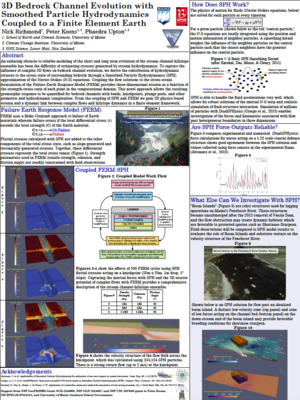Annualmeeting:2017 CSDMS meeting-006: Difference between revisions
NWRichmond (talk | contribs) (Created page with "{{CSDMS meeting personal information template-2014 |CSDMS meeting first name=Nick |CSDMS meeting last name=Richmond |CSDMS meeting institute=University of Maine |CSDMS meeting...") |
No edit summary |
||
| (3 intermediate revisions by 2 users not shown) | |||
| Line 14: | Line 14: | ||
}} | }} | ||
{{CSDMS meeting select clinics1 | {{CSDMS meeting select clinics1 | ||
|CSDMS_meeting_select_clinics1= | |CSDMS_meeting_select_clinics1=2) ANUGA - river flood morphodynamics | ||
}} | }} | ||
{{CSDMS meeting select clinics2 | {{CSDMS meeting select clinics2 | ||
| Line 23: | Line 23: | ||
}} | }} | ||
{{CSDMS scholarships yes no | {{CSDMS scholarships yes no | ||
|CSDMS meeting scholarships= | |CSDMS meeting scholarships=No | ||
}} | }} | ||
{{CSDMS meeting abstract yes no | {{CSDMS meeting abstract yes no | ||
|CSDMS meeting abstract submit=Yes | |CSDMS meeting abstract submit=Yes | ||
}} | }} | ||
{{CSDMS meeting abstract title temp}} | {{CSDMS meeting abstract title temp | ||
{{CSDMS meeting abstract template}} | |CSDMS meeting abstract title=3D Bedrock Channel Evolution with Smooth Particle Hydrodynamics Coupled to a Finite Element Earth | ||
}} | |||
{{CSDMS meeting authors template | |||
|CSDMS meeting coauthor first name abstract=Peter | |||
|CSDMS meeting coauthor last name abstract=Koons | |||
|CSDMS meeting coauthor institute / Organization=University of Maine | |||
|CSDMS meeting coauthor town-city=Orono | |||
|CSDMS meeting coauthor country=United States | |||
|State=Maine | |||
|CSDMS meeting coauthor email address=peter.koons@maine.edu | |||
}} | |||
{{CSDMS meeting authors template | |||
|CSDMS meeting coauthor first name abstract=Phaedra | |||
|CSDMS meeting coauthor last name abstract=Upton | |||
|CSDMS meeting coauthor institute / Organization=GNS Science | |||
|CSDMS meeting coauthor town-city=Lower Hutt | |||
|CSDMS meeting coauthor country=New Zealand | |||
|CSDMS meeting coauthor email address=P.Upton@gns.cri.nz | |||
}} | |||
{{CSDMS meeting abstract template | |||
|CSDMS meeting abstract=An enduring obstacle to reliable modeling of the short and long term evolution of the stream channel-hillslope ensemble has been the difficulty of estimating stresses generated by stream hydrodynamics. To capture the influence of complex 3D flows on bedrock channel evolution, we derive the contribution of hydrodynamic stresses to the stress state of surrounding bedrock through a Smoothed Particle Hydrodynamics (SPH) approximation of the Navier-Stokes (N-S) equations. The GPU-accelerated SPH solution locally integrates the N-S equations by discretizing the flow into millions of particles which communicate local motions to neighbor particles using a smoothing kernel. Coupling the flow solutions to the stress-strain formulation of the Failure Earth Response Model (FERM) provides three-dimensional erosion as a function of the strength-stress ratio of each point in the computational domain. This novel approach allows the resulting geomorphic response to be quantified for bedrock channels with bends, knickpoints, plunge pools, and other geometric and hydrodynamic complexities. Strength parameters used in FERM (tensile strength, cohesion, and friction angle) are readily constrained with field observations. Fluvial stresses calculated with SPH are added to the other components of the total stress state, such as slope-generated and tectonically-generated stresses. From the coupling of SPH and FERM we gain 3D physics-based erosion and a dynamic link between complex flows and hillslope dynamics in a finite element framework. Initial results indicate that the inertial forces generated by a simple 45° bend in a bedrock channel exceed the shear forces by a factor of two or more. Capturing these inertial forces and their 3D erosive potential provides a more complete understanding of the stream channel-hillslope ensemble. | |||
|CSDMS meeting posterPDF=Richmond_CSDMS_2017.pdf | |||
|CSDMS meeting posterPNG=Richmond_CSDMS_2017.png | |||
}} | |||
{{blank line template}} | {{blank line template}} | ||
Latest revision as of 08:31, 2 June 2017
Browse abstracts
3D Bedrock Channel Evolution with Smooth Particle Hydrodynamics Coupled to a Finite Element Earth
An enduring obstacle to reliable modeling of the short and long term evolution of the stream channel-hillslope ensemble has been the difficulty of estimating stresses generated by stream hydrodynamics. To capture the influence of complex 3D flows on bedrock channel evolution, we derive the contribution of hydrodynamic stresses to the stress state of surrounding bedrock through a Smoothed Particle Hydrodynamics (SPH) approximation of the Navier-Stokes (N-S) equations. The GPU-accelerated SPH solution locally integrates the N-S equations by discretizing the flow into millions of particles which communicate local motions to neighbor particles using a smoothing kernel. Coupling the flow solutions to the stress-strain formulation of the Failure Earth Response Model (FERM) provides three-dimensional erosion as a function of the strength-stress ratio of each point in the computational domain. This novel approach allows the resulting geomorphic response to be quantified for bedrock channels with bends, knickpoints, plunge pools, and other geometric and hydrodynamic complexities. Strength parameters used in FERM (tensile strength, cohesion, and friction angle) are readily constrained with field observations. Fluvial stresses calculated with SPH are added to the other components of the total stress state, such as slope-generated and tectonically-generated stresses. From the coupling of SPH and FERM we gain 3D physics-based erosion and a dynamic link between complex flows and hillslope dynamics in a finite element framework. Initial results indicate that the inertial forces generated by a simple 45° bend in a bedrock channel exceed the shear forces by a factor of two or more. Capturing these inertial forces and their 3D erosive potential provides a more complete understanding of the stream channel-hillslope ensemble.

